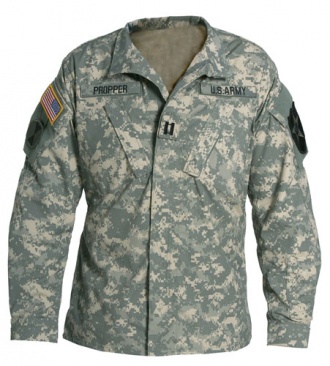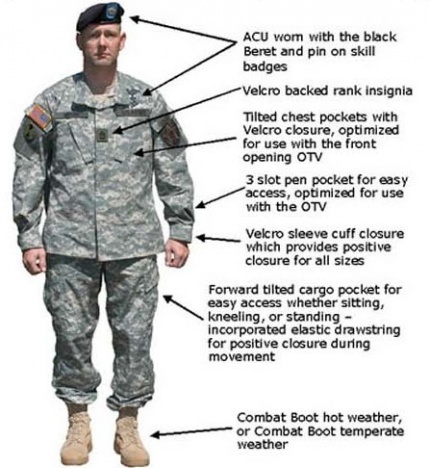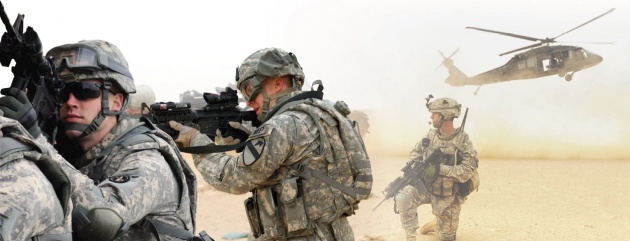ACU PAT (камуфляж): различия между версиями
Starik (обсуждение | вклад) |
Starik (обсуждение | вклад) |
||
| (не показано 7 промежуточных версий этого же участника) | |||
| Строка 2: | Строка 2: | ||
<keywords content="ACU PAT камуфляж, виды камуфляжа" /> | <keywords content="ACU PAT камуфляж, виды камуфляжа" /> | ||
Новая универсальная «цифровая» расцветка используемая армией США. При её разработке была взята за основу расцветка MARPAT из которой были исключены “пиксели” чёрного и зелёного цветов. Представляет собой прямоугольные пятнышки светло-,средне- и тёмно-серого цветов пересекающиеся между собой. Применяется сухопутными войсками на всех ТВД, будь то лесистая, горная или пустынная местность. | Новая универсальная «цифровая» расцветка используемая армией США. При её разработке была взята за основу расцветка MARPAT из которой были исключены “пиксели” чёрного и зелёного цветов. Представляет собой прямоугольные пятнышки светло-,средне- и тёмно-серого цветов пересекающиеся между собой. Применяется сухопутными войсками на всех ТВД, будь то лесистая, горная или пустынная местность. | ||
[[Изображение:10th-Mountain-Division-cтрайкбольная-команда_02.jpg| | [[Изображение:10th-Mountain-Division-cтрайкбольная-команда_02.jpg|430px|right|thumb|Пояснения по обмундированию. ]] | ||
<br> | |||
== Первообладание камуфляжем == | == Первообладание камуфляжем == | ||
'''Москва:''' нет данных. | '''Москва:''' нет данных. | ||
| Строка 28: | Строка 22: | ||
[[82nd Airborne cтрайкбольная команда|Cтрайкбольная команда 82nd Airborne]] | [[82nd Airborne cтрайкбольная команда|Cтрайкбольная команда 82nd Airborne]] | ||
[[ | [[Saints (19SFG) cтрайкбольная команда|Cтрайкбольная команда Saints (бывш. ODA 911)]] | ||
| Строка 40: | Строка 34: | ||
<br> | <br> | ||
Попытка сравнить камуфлирующие свойства Акупата и [[Multicam (камуфляж)|Мультикама]]. | Попытка сравнить камуфлирующие свойства Акупата и [[Multicam (камуфляж)|Мультикама]]. | ||
== Описание камуфляжа (нужна русская версия) == | |||
Army Combat Uniform, demonstrating the Universal Camouflage Pattern. WASHINGTON (Army News Service, June 14, 2004) - The Army will be fielding a new combat uniform designed by NCOs and tested by Stryker Brigade Soldiers in Iraq since October. | |||
On the Army's 229th birthday, senior leadership introduced the Army Combat Uniform during a Pentagon cake-cutting ceremony. Soldiers were on display, suited-up in the wrinkle-free uniform with a digitized camouflage pattern. | |||
Three different versions of the ACU have been developed, and more than 10,000 uniforms have been produced and dragged through the sand in Iraq and at Army training centers. Even more are on American production lines to be issued by April 2005 to Soldiers in deploying units. Fielding to the total Army should be complete by December 2007, said officials from the Program Executive Office, known as PEO Soldier. | |||
There were 20 changes made to the uniform, to include removing the color black and adapting the digital print from the Marine Corps uniform to meet the needs of the Army, said Sgt. 1st Class Jeff Myhre, the Clothing and Individual Equipment noncommissioned officer in charge. | |||
Black is no longer useful on the uniform because it is not a color commonly found in nature. The drawback to black is that its color immediately catches the eye, he added. | |||
"The color scheme in the ACU capitalizes on the environments that we operate in," Myhre said. "The current colors on the ACU are green-woodland, grey-urban environments and sand brown-desert. The pattern is not a 100-percent solution in every environment, but a good solution across the board." | |||
"This isn't about a cosmetic redesign of the uniform," said Col. John Norwood, the project manager for Clothing and Individual Equipment. "It's a functionality change of the uniform that will improve the ability of Soldiers to execute their combat mission." | |||
[[Изображение:10th-Mountain-Division-cтрайкбольная-команда_01.jpg|630px|right|thumb|10я горная дивизия армии ВС США периода войны в Афганистане ]] | |||
Every change was made for a reason. The bottom pockets on the jacket were removed and placed on the shoulder sleeves so Soldiers can have access to them while wearing body armor. The pockets were also tilted forward so that they are easily accessible. Buttons were replaced with zippers that open from the top and bottom to provide comfort while wearing armor. | |||
Patches and tabs are affixed to the uniform with Velcro to give the wearer more flexibility and to save the Soldier money, Myhre said. Soldiers can take the name-tapes and patches off their uniforms before laundering, which will add to the lifecycle of the patches. Also the cost to get patches sewn on will be eliminated, he added. | |||
The ACU will consist of a jacket, trousers, moisture wicking t-shirt and the brown combat boots. It will replace both versions of the BDU and the desert camouflage uniform. The black beret will be the normal headgear for the ACU, but there is a matching patrol cap to be worn at the commander's discretion. | |||
At $88 per uniform, about $30 more than the BDU, Soldiers will eventually reap gains in money and time by not having to take uniforms to the cleaners or shine boots. | |||
The life of the ACU began in January 2003 when PEO Soldier teamed with Myhre, Master Sgt. Alex Samoba and Staff Sgt. Matt Goodine - from the 1st Stryker Brigade, Fort Lewis, Wash. | |||
The team looked at a number of uniforms and took the best part of each uniform and combined it into one. They built their first prototype and delivered 25 uniforms to Stryker squads at the National Training Center. After listening to their comments, the team went back to the lab and created prototype two. | |||
Twenty-one uniforms were then delivered to Stryker Soldiers at the Joint Training and Readiness Center, Fort Polk, La. | |||
"We watched them as they entered and cleared rooms, as they carried their rucksack and all of the things they had to be able to do in the uniform, and then we came up with prototype three," Myhre said. | |||
Two issues of the third version were given to the Stryker Soldiers deploying to Iraq. Three months ago, Myhre was among a team who visited Iraq to get more feedback from Soldiers. | |||
"We would talk to Soldiers right after they had completed a mission while the benefits of the uniform were still fresh in their minds. We wanted to know how did the uniform help the mission." | |||
Sgt. Maj. of the Army Kenneth Preston is one of the ACU's biggest supporters. He said major command sergeants major had a chance to see the uniform and give advice toward the final version. | |||
"We have not made a major change to our uniforms since the BDUs (battle dress uniforms) were introduced in the early 1980s," Preston said. "This new uniform performs well in multiple environments. Its new pockets and color designs are a result of feedback from Soldiers in combat. Every modification made on the uniform was designed with a specific purpose and not just for the sake of change." | |||
Uniform changes include: | |||
1. Mandarin collar that can be worn up or down | |||
2. Rank insignia centered on the front of the blouse | |||
3. Velcro for wearing unit patch, skill tabs and recognition devices | |||
4. Zippered front closure | |||
5. Elbow pouch for internal elbow pad inserts | |||
6. Knee pouch for internal knee pad inserts | |||
7. Draw string leg cuff | |||
8. Tilted chest pockets with Velcro closure | |||
9. Three-slot pen pocket on bottom of sleeve | |||
10. Velcro sleeve cuff closure | |||
11. Shoulder pockets with Velcro | |||
12. Forward tilted cargo pockets | |||
13. Integrated blouse bellows for increased upper body mobility | |||
14. Integrated Friend or Foe Identification Square on both left and right shoulder pocket flap. | |||
15. Bellowed calf storage pocket on left and right leg | |||
16. Moisture-wicking desert tan t-shirt | |||
17. Patrol Cap with double thick bill and internal pocket | |||
18. Improved hot-weather desert boot or temperate-weather desert boot | |||
19. Two-inch, black nylon web belt | |||
20. Moisture-wicking socks | |||
== Ссылки == | == Ссылки == | ||
| Строка 47: | Строка 123: | ||
[[Категория:Виды камуфляжа]] [[Категория:Страйкбол и военное дело]] [[Категория:Камуфляж США]] | [[Категория:Виды камуфляжа]] [[Категория:Страйкбол и военное дело]] [[Категория:Камуфляж США]] | ||
[[Категория:Камуфляж НАТО]] | |||
Текущая версия на 23:04, 12 декабря 2011
<metadesc>ACU PAT камуфляж</metadesc>
<keywords content="ACU PAT камуфляж, виды камуфляжа" /> Новая универсальная «цифровая» расцветка используемая армией США. При её разработке была взята за основу расцветка MARPAT из которой были исключены “пиксели” чёрного и зелёного цветов. Представляет собой прямоугольные пятнышки светло-,средне- и тёмно-серого цветов пересекающиеся между собой. Применяется сухопутными войсками на всех ТВД, будь то лесистая, горная или пустынная местность.
Первообладание камуфляжем[править]
Москва: нет данных.
Санкт-Петербург: нет данных.
Псков: нет данных.
Команды использующие камуфляж ACUPAT[править]
Москва: нет данных.
Санкт-Петербург:
Cтрайкбольная команда 10th Mountain Division
Cтрайкбольная команда 82nd Airborne
Cтрайкбольная команда Saints (бывш. ODA 911)
Псков: нет данных.
Попытка сравнить камуфлирующие свойства Акупата и Мультикама.
Описание камуфляжа (нужна русская версия)[править]
Army Combat Uniform, demonstrating the Universal Camouflage Pattern. WASHINGTON (Army News Service, June 14, 2004) - The Army will be fielding a new combat uniform designed by NCOs and tested by Stryker Brigade Soldiers in Iraq since October.
On the Army's 229th birthday, senior leadership introduced the Army Combat Uniform during a Pentagon cake-cutting ceremony. Soldiers were on display, suited-up in the wrinkle-free uniform with a digitized camouflage pattern.
Three different versions of the ACU have been developed, and more than 10,000 uniforms have been produced and dragged through the sand in Iraq and at Army training centers. Even more are on American production lines to be issued by April 2005 to Soldiers in deploying units. Fielding to the total Army should be complete by December 2007, said officials from the Program Executive Office, known as PEO Soldier.
There were 20 changes made to the uniform, to include removing the color black and adapting the digital print from the Marine Corps uniform to meet the needs of the Army, said Sgt. 1st Class Jeff Myhre, the Clothing and Individual Equipment noncommissioned officer in charge.
Black is no longer useful on the uniform because it is not a color commonly found in nature. The drawback to black is that its color immediately catches the eye, he added.
"The color scheme in the ACU capitalizes on the environments that we operate in," Myhre said. "The current colors on the ACU are green-woodland, grey-urban environments and sand brown-desert. The pattern is not a 100-percent solution in every environment, but a good solution across the board."
"This isn't about a cosmetic redesign of the uniform," said Col. John Norwood, the project manager for Clothing and Individual Equipment. "It's a functionality change of the uniform that will improve the ability of Soldiers to execute their combat mission."
Every change was made for a reason. The bottom pockets on the jacket were removed and placed on the shoulder sleeves so Soldiers can have access to them while wearing body armor. The pockets were also tilted forward so that they are easily accessible. Buttons were replaced with zippers that open from the top and bottom to provide comfort while wearing armor.
Patches and tabs are affixed to the uniform with Velcro to give the wearer more flexibility and to save the Soldier money, Myhre said. Soldiers can take the name-tapes and patches off their uniforms before laundering, which will add to the lifecycle of the patches. Also the cost to get patches sewn on will be eliminated, he added.
The ACU will consist of a jacket, trousers, moisture wicking t-shirt and the brown combat boots. It will replace both versions of the BDU and the desert camouflage uniform. The black beret will be the normal headgear for the ACU, but there is a matching patrol cap to be worn at the commander's discretion.
At $88 per uniform, about $30 more than the BDU, Soldiers will eventually reap gains in money and time by not having to take uniforms to the cleaners or shine boots.
The life of the ACU began in January 2003 when PEO Soldier teamed with Myhre, Master Sgt. Alex Samoba and Staff Sgt. Matt Goodine - from the 1st Stryker Brigade, Fort Lewis, Wash.
The team looked at a number of uniforms and took the best part of each uniform and combined it into one. They built their first prototype and delivered 25 uniforms to Stryker squads at the National Training Center. After listening to their comments, the team went back to the lab and created prototype two.
Twenty-one uniforms were then delivered to Stryker Soldiers at the Joint Training and Readiness Center, Fort Polk, La.
"We watched them as they entered and cleared rooms, as they carried their rucksack and all of the things they had to be able to do in the uniform, and then we came up with prototype three," Myhre said.
Two issues of the third version were given to the Stryker Soldiers deploying to Iraq. Three months ago, Myhre was among a team who visited Iraq to get more feedback from Soldiers.
"We would talk to Soldiers right after they had completed a mission while the benefits of the uniform were still fresh in their minds. We wanted to know how did the uniform help the mission."
Sgt. Maj. of the Army Kenneth Preston is one of the ACU's biggest supporters. He said major command sergeants major had a chance to see the uniform and give advice toward the final version.
"We have not made a major change to our uniforms since the BDUs (battle dress uniforms) were introduced in the early 1980s," Preston said. "This new uniform performs well in multiple environments. Its new pockets and color designs are a result of feedback from Soldiers in combat. Every modification made on the uniform was designed with a specific purpose and not just for the sake of change."
Uniform changes include:
1. Mandarin collar that can be worn up or down
2. Rank insignia centered on the front of the blouse
3. Velcro for wearing unit patch, skill tabs and recognition devices
4. Zippered front closure
5. Elbow pouch for internal elbow pad inserts
6. Knee pouch for internal knee pad inserts
7. Draw string leg cuff
8. Tilted chest pockets with Velcro closure
9. Three-slot pen pocket on bottom of sleeve
10. Velcro sleeve cuff closure
11. Shoulder pockets with Velcro
12. Forward tilted cargo pockets
13. Integrated blouse bellows for increased upper body mobility
14. Integrated Friend or Foe Identification Square on both left and right shoulder pocket flap.
15. Bellowed calf storage pocket on left and right leg
16. Moisture-wicking desert tan t-shirt
17. Patrol Cap with double thick bill and internal pocket
18. Improved hot-weather desert boot or temperate-weather desert boot
19. Two-inch, black nylon web belt
20. Moisture-wicking socks


